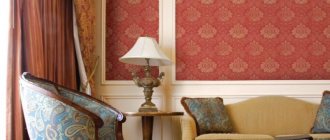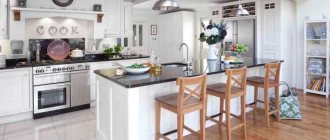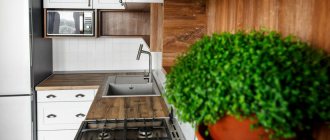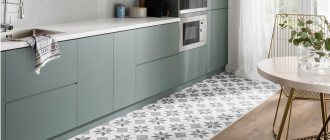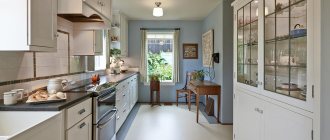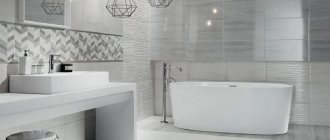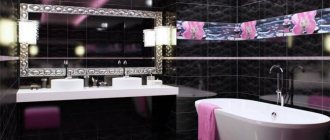White flooring in the interior is one of the fashion trends often used by designers. The need for careful care of a light-colored surface is compensated by wide scope for creativity and the implementation of original creative ideas, which will be discussed below.
White floors are beautiful, but require special care Source www.maureengreencny.com
What kind of floor should the kitchen have?
The floor in the kitchen, especially in homes where cooking is frequent, is subject to intensive use. And this leads to spillage of water, milk or oil, as well as falling peels, heavy knives or pots, breaking eggs or glasses. Therefore, the ideal floor should be:
- easy to clean;
- Resistant to stains, scratches and breakage.
It would also be nice if the kitchen floor is pleasant on your feet. The choice of finishing materials for this part of the room is huge, so the decision requires thought. It’s worth thinking about what is more important to you: practical or aesthetic considerations? Or maybe you can connect one to the other? Explore an overview of various materials. Look at the disadvantages and advantages of each. Choosing a kitchen floor is a decision that will last for many years.
Two main elements determine which floor to choose for the kitchen:
- the first is durability and ease of maintenance;
- second, it is important to integrate it into a holistic interior design.
The floor in the kitchen should be practical, but also decorate the room.
Natural stone floor in the kitchen: photos of beautiful ideas
Natural stone can come in the form of marble, slate, limestone, sandstone or travertine, but all require more or less long-term protection for the floor to last for many years. In terms of strength, granite will be an almost ideal stone for a kitchen floor, since it:
- has very high mechanical resistance, including abrasion;
- insensitive to moisture, high temperature;
- can be used in rooms with intensive use;
- chemically resistant.
While the colors and patterns available won't appeal to everyone, most varieties of this rock are characterized by a cool, heavy sheen, granite has a visually completely different tone than, for example, marble, sandstone or travertine, which offer warmer colors. However, granite has quirky, unique and intriguing patterns, but it all depends on individual taste.
Since it is a natural material, each option is different and will therefore be unique. The material is great as it is scratch and break resistant. Some types have a porous, rough texture and are susceptible to contamination, they can discolor and even absorb grease. Most stone floors require impregnation. Each flooring stone has its own advantages and disadvantages.
Advantages:
- natural;
- luxurious;
- very effective.
Flaws:
- cold and heavy;
- needs impregnation;
- Expensive.
Obviously, you need to have a much larger budget compared to the amount required to purchase tiles, but at the end of the day, stone is about undeniable style and elegance. Caring for the stone is simple, you just need to use cleaning products for this material.
Because it is a natural material, each stone (even of the same type) is different, so the floor will be unique. This type of floor can be used for years (especially with granite) because the stone is resistant to scratches and breakage. Some types, however, have a porous, rough texture and are susceptible to contamination; they can become discolored and even absorb grease. Most stone floors require impregnation.
Design Ideas for Light Flooring
Light wood floors can suit many different types of interior design, some of the most popular include:
- modern style, which consists of sleek lines, minimalist decor and furniture, combined with neutral soft shades of light flooring;
- Shabby Chic: a style with white, linen shades, accents are traditionally expressed in pastel fabrics and weathered furniture;
- Scandinavian style designed to create bright, large spaces suitable for northern latitudes, hidden in darkness for most of the year.
Light floors open up many interesting design ideas. Below are some ideas to get you started.
Modern style
In the corridor
If there is a best place for light floors, it is in the hallway. By nature, hallways tend to be dark due to limited space, but light flooring combined with light walls can easily brighten it up.
We're dealing with a high-traffic room here, so you need to choose a flooring material that's durable and easy to clean and maintain. Your hallway flooring should stand the test of time no matter how often you change your decor.
Consider the age and style of your property first. For a country house, traditional materials such as wood and tiles are suitable. And in a modern city apartment, polished concrete or painted floors look good. Stone tiles and old brick look beautiful in old-fashioned country cottages. But for a more upscale, elegant style, choose a black and white checkerboard tile design that would suit a classic townhouse.
Hallway interior in minimalist style
The color of the floors also depends on the size of your hallway. Dark polished wood flooring or terracotta tiles in a deep red shade will make a small hallway feel smaller. Lighter wood or neutral colored tiles will help improve the feel of the space when paired with a white or cream decorative scheme.
Tip Keep in mind that there is a wide range of materials to choose from. Therefore, if you want wood flooring but require less maintenance, choosing ceramic tiles may be your best bet.
Ceramics can imitate wooden boards in a variety of colors and finishes.
The color of the floors also depends on the size of your corridor
In the living room
The living room is warm and cozy with light floors. It has a beach house vibe that will make you think of summer all year round - even during the cold winter months.
Add some neutral seating (wicker or rattan are great choices). Several house plants, white furniture, neutral accessories (light gray, beige, dark brown) will improve the appearance of the house. These tricks will allow you to achieve an easy, practical, yet luxurious effect. Draw visual interest with texture rather than color to maintain the airy feel of the room.
This color will make the living room warm and cozy
In the bathroom
Many natural stone tiles come in many matching colors, so you can choose your own combination of shades. Keep your cabinets in the same tone as your tiles and your bathroom will instantly open up.
In the bedroom
In the bedroom, light flooring has an expressive effect. If you like a comfortable, airy look, then light flooring is an important step towards creating the perfect bedroom.
For a traditional look, use a variety of organic materials in white or neutrals: wood, wicker, cotton, wool. Keep your bed minimalistic and avoid dark metal. Woven and wicker headboards are perfect for such an interior. Again, playing with textures balances out the all white look.
Comfortable, airy bedroom look
In contemporary style
It is still possible to have a modern bedroom in light colors. Just focus on shape and shine using metal and geometric shapes. A black or dark mark as an accent color will bring out just the right amount of visual interest.
Wooden floor in the kitchen
Wood flooring in the kitchen never goes out of style, but can it be used in this area of the home since the room is exposed to a lot of splashes, stains, and impacts from falling objects? Yes, but it is worth choosing the right processing and ensuring safety. What if we have old boards or damaged parquet?
A wooden floor will definitely be warm, not only visually, but also physically, to the touch. Wood also has good sound insulation and looks the most natural of all types of flooring. Arranging with a wooden floor carries signs of comfort. In the kitchen, you can spill something on the floor or a sharp object will fall, so the surface must be resistant to moisture and mechanical damage.
It is recommended to use harder and less moisture-sensitive species of exotic trees, since they have a low shrinkage rate, these will be teak, iroko, merbau, dussey or conventionally native deciduous species, for example, oak, ash, larch. Exotic species contain a large amount of tannins in resin oils, which has a positive effect, for example, on resistance to fungi.
Advantages:
- warms and dampens the interior;
- the floor is warm and pleasant to the touch;
- timeless, elegant and durable;
- it can be updated.
Flaws:
- high price;
- demanding styling.
A wooden floor in a damp interior requires significant maintenance, so it must be lubricated with oil or varnish, but the first option best saturates the wood, penetrating deeply into its pores.
In the event of destruction, only parts of the surface of the oiled floor can be repaired, so that there will be no significant difference between the pieces of the surface. In the varnish option, here you need to clean and coat the entire floor with solution to make it perfect. Oil, wax or other special preparation can emphasize the pattern and structure of the wood, while the floor will take on a very natural look. Gloss varnish will give the floor shine because it reflects up to 90% of the light. Semi-matte varnish is also a good choice. If you want to emphasize the wood grain, you can use so-called “invisible” varnish; the floor will look raw. The only drawback of an oiled floor is the need for systematic application of paste and annual thorough impregnation. But a waxed surface requires even more care; it is in this case that the varnished version has an advantage in care.
Laminate flooring for kitchen
Laminate will be the cheapest solution, but not the most practical. An almost perfect imitation of wood structure and pattern, a huge variety of colors and patterns encourages modern buyers to purchase laminated panels. If you have already decided on it as a flooring material, then make sure that the stationary surface is flat, without depressions and bulges on which the panel joints can be deformed. The laminate must have a minimum wear class of AC4. It is difficult to damage such a floor with anything sharp; in this regard, it will be better than even the hardest wood. The disadvantage of laminate is its greater sensitivity to moisture, which can lead to lifting at the joints due to irreversible swelling of the MDF layer. Although there are special, more expensive panels on the market with elastic bands/gaskets at the joints, this will prevent water penetration to some extent, but not completely because this finish is a floating floor. Remember that a laminate coating will never be as durable and insensitive to moisture as a surface, for example, made of glazed porcelain tiles or natural stone.
Flaws
- The main disadvantage is that it is very difficult and expensive to dismantle.
- Possibility of small cracks if installed incorrectly.
- Use personal protective equipment and good ventilation during installation.
- 3D floors can get boring quickly, usually due to ill-thought-out choices.
- Regular ventilation is necessary; self-leveling floors do not “breathe”.
The main thing that you need to pay special attention to when creating a self-leveling floor is the use of only high-quality materials. Appearing defects, unpleasant odors or increased fragility are signs of the use of low-quality materials and low qualifications of workers. Carefully consider the glossy floor options you like in the photo and think about your decision. Don’t make mistakes when developing a design project and carefully choose quality materials.
Porcelain tiles for the kitchen floor
Porcelain tile is a material with:
- low water absorption;
- very high abrasion resistance;
- resistance to various stains;
- cleaning with standard detergents;
- problematic damage to the surface by a hard and heavy object.
Polished porcelain tiles are as hard as glazed ones, but they have much higher water absorption, which makes them easy to stain, for example with coffee, wine, fruit juice or ink, although it can be cleaned with a special stain remover, but this is quite a hassle. If polished, the gloss may fade over the years in more used areas, but it certainly has its own charm, characterized by a more intense color. Polished porcelain tiles look more natural, but due to their micro-porosity they require impregnation immediately after installation.
Porcelain tiles are different from terracotta or clinker. These tiles, compared to hard ceramics, wear out faster and break more easily. There is also a natural and technical material called gres. It has all the advantages of glazed tiles, except for the aesthetic value, as it has slightly different proportions of components. The material contains high-quality clay, which affects aesthetics and color diversity. You may see natural grain on terraces or staircases, although some tile collections can match kitchen decor but in an extremely minimalist, almost ascetic style. Ceramic tiles on the floor of the cooking room are the most common option.
Gres is a type of very hard ceramic tile. It can be polished and looks impressive, but it is not resistant to stains and dirt that gets into the micropores, so it needs to be soaked. A tile called glazed gres does not require impregnation, as it does not leave stains and does not absorb moisture. Unfortunately, as a result of, for example, a blow or falling of a heavy object, a piece may break off. You can choose from a variety of surface finishes, including polished, satin, lappato. Gres will ideally imitate natural materials, such as wood or granite.
How to prepare the premises and start working?
The name “self-leveling floor” speaks for itself. After the dry mixture dissolves in water and turns into liquid, it is poured onto the surface. The self-leveling characteristics of the mixture allow it to fill all uneven areas under the influence of gravity. Before starting work, you need to clear the room of existing furniture. The next step is to get rid of the old floor covering; wooden flooring is no exception. We must try to ensure that the floor is as level as possible, free of debris, dust and dirt. The preparatory work is completed - and you can begin. Many companies specialize in installing self-leveling floors, so professionals will complete all work quickly and efficiently. Of course, in a small room you can cope with this task yourself. A large floor area will require a considerable number of workers, because uneven surfaces will be more noticeable here. Despite the apparent simplicity of operation, self-leveling floors are very sophisticated. After pouring, they form a smooth, perfect surface. In the future, such a floor can act as:
- base for further finishing with tiles, parquet, laminate;
- self-coating after applying a decorative finish.
Ceramic tiles for kitchen flooring
Ceramic kitchen floor tiles are extremely popular and come in countless sizes, designs and colors. Everyone can easily choose the option that suits both their kitchen style and taste. In a modern design, uniform polished tiles measuring 60 x 60 cm are suitable, while rustic ones are matte with uneven edges, a little reminiscent of stone. In turn, wood tiles will make the interior more comfortable. You can easily find tiles at a price that suits your needs.
Advantages:
- resistant to damage and abrasion;
- easy to clean;
- you can find cheap and nice options;
- looks beautiful and elegant;
- There is a wide range of designs and colors available in the market.
Flaws:
- the floor is hard and cold, so you should consider heating it;
- if a heavy object falls, it may be damaged;
- polished material is very slippery, especially when wet.
Volume effect
Due to the refraction of light and thanks to the multi-layer construction of glossy floors, volume is achieved. The three-dimensional effect is created by using several layers of varnish, between which parts of the design are located. Self-leveling flooring, which creates a three-dimensional three-dimensional image, is the most beautiful and very unusual. This could be applying paint directly between layers of varnish, or using vinyl film or banner fabric with an image. You can order or make any image. It could be flowers, animals, water.
However, sometimes these pictures seem out of place from the outside. Therefore, you should think very carefully when placing images of monsters from the film under your feet. Other shocking images, of course, will tickle the nerves of guests and hosts, but can quickly become boring. But dismantling such a floor is difficult and expensive. Sometimes the patterns repeat the patterns on walls or textiles. When using vinyl film, part of the picture will be located on the floor, on the walls and furniture - its continuation. If you wish, you can also capture the ceiling! Another option is to place various decorations on the floor, for example, shells, stones, coins, before pouring the polymer. Lastly, varnish is applied, which protects and gives the same 3D effect. To prevent fading of a particularly bright design, an additional layer of varnish with an ultraviolet coating is required.
Kitchen floor design - brick
A brick floor is a relatively rare solution, but extremely interesting. Gives the interior a somewhat old-fashioned and rustic look. Works well in a stylish country house or an apartment in an older building. Few people today decide to install such a floor in a newly built house, but if you bought a home with this finish, do not change it to another.
Advantages:
- very decorative and original;
- durable.
Flaws:
- bulky masonry;
- the brick floor is heavy;
- not very resistant to dirt because it has an uneven surface.
Kitchen floor - concrete
Concrete floors pair perfectly with minimalist interiors with large glass areas, as well as industrial and loft-style designs. Smooth concrete surfaces optically increase space and provide an excellent neutral background for kitchen furniture and accessories. They go well with any type of wood. Using special paint, you can paint such a floor entirely or according to a pattern using a template.
Advantages:
- relatively cheap solution;
- the floor is durable, resistant to abrasion and cracking;
- easy to clean (no gaps), does not require maintenance.
Flaws:
- cold and hard, so it is recommended to install heating;
- installation takes a lot of time.
All shades of white
White color is a universal basis for creating many light shades used in floor design. Small additions of yellow, gray, brown and other colors make it possible to obtain rich and multifaceted shades that are pleasing to the eye. This approach allows you to expand the possibilities of using white.
Glossy white surfaces visually increase the space Source cdn.n1.ru
These include the following:
- snow-white;
- cream;
- almond;
- ecru;
- cotton and others.
For your information! All shades created on the basis of white can be used for contrasting or monochrome design.
Kitchen Vinyl Flooring
Flexible and easy to install, vinyl flooring allows for quick transformation inside. And when you get tired of it, it’s easy to remove this coating yourself without taking much time. The price is comparable to laminated panels, but does not give the unpleasant “knocking” effect. New generation vinyl flooring also perfectly imitates natural materials such as wood, ceramic and stone. The range of designs is virtually unlimited, so it's easy to choose a finish to suit your interior style.
Advantages:
- can be laid on old floors;
- warm and pleasant to the feet;
- waterproof and non-slip coating;
- inexpensive material.
Flaws:
- not very resistant to scratches and cuts;
- Not everyone likes the “plastic” look.
White color: advantages and disadvantages
When choosing this option for organizing flooring, you need to take into account all its strengths and weaknesses. White floor color has many advantages:
- versatility;
- good compatibility with most styles;
- visually increases the space;
- has a calming effect;
- favorably emphasizes design solutions;
- camouflages dust;
- can serve as a companion color for other shades.
Simple, but at the same time chic interior Source i.pinimg.com
This is a suitable color for creating laconic minimalist interiors, modern, for example, high-tech. To organically match the design style, the texture of finishing materials must be carefully selected.
Disadvantages of white coating:
- despite masking dust, it is not able to hide scratches, stains and other damage;
- Frequent cleaning is required;
- sometimes not suitable for interiors in dark colors.
For your information! White can serve as a background for bright compositions or can itself serve as an accent against the background of other colors.
Kitchen floors: which is the best new material?
EcoMalta is a quartz solution. The main ingredient is quartz and other minerals and aggregates. The solution dries and becomes hard, very resistant to temperature changes, abrasion, and mechanical damage. It is also a moisture-resistant, washable floor that will not discolor. Thanks to its high flexibility, you can achieve up to several tens of meters of continuous, smooth surface. This surface gives the interior a slightly raw, industrial look, but unlike materials containing cement, it is warm and pleasant to the touch. However, it can be classified as an ecological floor, since it does not contain cement, lime, plaster, or epoxy resins. The diluent is water, thanks to which it does not cause allergies, does not increase CO2 production and does not dry out the air inside. EcoMalta is 2-3 mm thick and can also be used for underfloor heating.
Laminam is sintered quartz. It consists of only quartz and water, so it is 100% natural. Thanks to special technology, the mixture is subjected to very high temperatures and intense pressure, creating an extremely hard material. The boards are manufactured in 324 x 162 cm and 300 x 100 cm formats. They have better performance characteristics than natural stone, as they are durable, resistant to mechanical damage, high temperatures and staining (for example, fruit acid, wine). The material does not discolor or change its appearance for years.
Should I use glossy laminate?
The surface of laminated surfaces may differ not only in color, but also in texture, which can be matte or glossy. Each of these types of flooring has its own characteristics.
Unusual glossy white laminate
Recently, glossy white laminate flooring has become increasingly popular in interiors, with its rather unusual appearance. This becomes possible due to the reflection of light from the surface. Some time ago, glossy laminate was used only by the most daring interior designers. Now this option is gaining more and more popularity, which it has won for well-founded reasons.
Glossy white laminate in apartment interiors is now very popular
At first glance, white laminate, and even with a glossy surface, can give the impression of a very easily soiled floor covering. However, this minus is offset by a lot of advantages. This surface is perfectly flat and smooth, but at the same time absolutely non-slippery. Glossy reflections add more uniqueness and brightness to any room. Despite the fact that such a laminate gets dirty easily, caring for it is as simple as possible, since all stains are erased in no time. Even ashes and hot liquids are not afraid of him.
Glossy reflections add more uniqueness to any room
Glossy white laminate in the interior of the apartment is not afraid of ultraviolet rays, has high wear resistance and does not wear off over time. As an additional advantage, we can note the environmental friendliness of the material. Often a coating of silver ions is applied on top of the glossy surface, which makes such a floor also very beneficial for health.
Glossy white laminate is highly durable
Warm floor in the kitchen - plug
Cork is natural and environmentally friendly. Excellent insulation thermally (comparable to polystyrene and mineral wool) and acoustically. The material is flexible because it can be pressed, but quickly returns to its previous state. It is easy to install because it is in the form of tiles or panels. The kitchen should be covered with a layer of moisture-resistant varnish. Cork is warm to the touch and electrostatic, as it does not attract dust, so it is safe for allergy sufferers. The material is resistant to fungi and mold. When in contact with fire, it ignites slowly and slowly. Interiors lined with cork seem more comfortable, and most importantly, warm.
Advantages:
- the floor is warm and pleasant for bare feet;
- soft, flexible and non-slip;
- improves internal acoustics.
Flaws:
- requires careful installation;
- Not everyone likes the grainy texture of cork.
Floor in the kitchen-living room
As mentioned earlier, the floor is increasingly covered with one material over the entire surface of a house or apartment. This way you can optically enlarge the space and create a coherent layout. A very interesting visual effect can be achieved when, after crossing the threshold from the hallway level, you see that the floors in other rooms, including the kitchen, have been lined with the same material. This type of stylistic consistency gives interiors a harmonious expression.
Some designers discourage using the same flooring material in all rooms, so if the kitchen is combined with the living room, it is worth considering the possibility of covering the surfaces with different materials in this space, especially if you want the kitchen and living room to form an interesting tandem. This is a very common solution that allows you to create a fashionable and stylish living space.
Light and dark flooring
By pairing the right floor color with the right wall color, we can make the most of the space we have. As a general rule, lighter colors will open up the room and make it appear larger, while darker colors will make the space appear smaller. Playing with different combinations of these options, however, can make a room look very different:
- Light floors will make your room feel more airy and optically larger. They are also capable of giving a cleaner, more traditional look. Lighter colors on the floors go well with dark and light walls.
- Dark floors are a must for those who want to add some contrast to their space, they will add an instant dramatic effect to the room.
Match the right floor color with the right wall color
- The combination of dark and light colors on the floors and walls can change not only the appearance of the room. Different combinations on the surface of your space can instantly shift the feel of the room.
- Using light colors on the floors and walls makes the space look too large. This makes the room feel less cozy, personal and warm than you probably want it to be.
- Conversely, adding one powerful accent in the form of a dark wall will make the space a little smaller and more expressive. Leave the other three walls and the floor light. Create an accent wall with function using bright colors.
By combining light walls with darker ones, you can visually narrow the room, make it deeper and taller. However, you need to leave the overhead light in this ratio so that the space is not closed.
- Dark walls in a room with light floors and ceilings will force the eye to follow horizontal lines. This trick is needed to make the room look wider.
- By keeping the flooring lighter and making the walls and ceiling dark, you will have a room that is visually smaller.
A fluffy carpet will add coziness to the room
- Using a dark floor with light walls and ceiling will instantly make the room feel wider. This is a great combination if you need to open up a space without being overly spacious.
- Dark colors on the floor and ceiling will make the room appear wider and the ceiling will appear lower.
- To ensure that light from the room comes from above, look at dark floors and walls. This combination can give the room a "basement" feel.
Once you start experimenting with colors, you will see how different the same room can look.
The impact of light and shadow in a space can be enormous.
In the interior of the kitchen
Kitchen floor color
The floor in the kitchen should match the color of the interior and also be in harmony with other rooms. Therefore, a good and increasingly used solution is to lay the entire house or apartment with one material. When choosing a color, remember that the kitchen floor should be versatile and timeless enough that it looks good when changing furniture or accessories, and, despite the length of use, still pleases with its impeccable beauty.
White floor in the kitchen
It may seem like white flooring won't work in a kitchen, but with the right impregnation, it can be protected from stains or other dirt. Thanks to several varnish coatings using UV technology, the floor will meet high quality criteria. It is very important that the varnish layer does not create an artificial effect on the boards, because the natural structure of the oak stands out from under it. Thus, a white floor is both practical and beautiful.
Light floor in the kitchen
A light kitchen floor is not just white. You can also choose boards coated with clear or lightly colored oils or varnishes. Many interesting offers can be found in the photo gallery. People who prefer light kitchen floors that delight with their naturalness will certainly like boards such as: honey, vanilla, champagne, prosecco, etc.
Gray floor in the kitchen
Currently, gray is very popular in interiors. Today you can choose colors in several shades. Among them are the boards: white and gray pearl. Gray flooring fits very well in kitchens with white and brown cabinetry.
Kitchen with dark floor
A black floor is more of a solution for brave people who like brighter color accents in the interior. It will look especially good against a light background such as walls, furniture and other equipment. This way, you will not overload the room, but rather increase its visual qualities.
Black and white floor in the kitchen
Can't decide on just one color for your kitchen floor? Perhaps in this case you will like the idea of combining white and black boards, arranged, for example, in a French, Hungarian or traditional herringbone pattern. The herringbone flooring method is now very fashionable again and looks stylish. Can be used in both modern and traditional interiors. This flooring will add class and elegance to any interior. Consider a checkerboard design, which offers virtually unlimited possibilities when it comes to perfect kitchen interiors.
How to combine white with others
All shades, from light to dark, go well with white. The selection of companion colors will influence the subsequent perception of the interior.
Design in monocolor Source www.remont.vgceiling.ru
See also: Catalog of Mediterranean style house projects.
The classic combination is white with black and red. The contrast of shades allows you to highlight details and correctly place accents. An example would be the design of the floor in white, the walls in black, and the presence of red accents. Or, alternatively, a combination of black and white tiles.
Black and white design Source static1.abitant.com
White plus sunny orange and yellow lift your spirits and charge you with energy when choosing bright shades. Pale yellow and washed out orange and white look much calmer and more elegant.
Yellow – as a companion color Source www.sefaart.com.tr
The emphasis on purple is often made by creative individuals who have many interests and are constantly developing. The perception of design in blue and green, with the presence of a white floor, also depends on the selected shades. It can be contrasting and catchy with bright blue and sleepy green, or create the impression of a romantic and soft atmosphere when choosing soft blue and light light green tones.
Unusual design in shades of lilac Source boxtoner.ru
A multifaceted classic combination can be white, which is mixed with a brown range of colors. At the same time, the result is warm, creamy chocolate combinations that do not irritate the eyes and can serve as the basis even for a classic interior.
Chocolate and white combination Source content3.jdmagicbox.com

